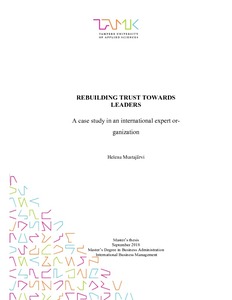Rebuilding trust towards leaders : a case study in an international expert organization
Mustajärvi, Helena (2018)
Mustajärvi, Helena
Tampereen ammattikorkeakoulu
2018
All rights reserved
Julkaisun pysyvä osoite on
https://urn.fi/URN:NBN:fi:amk-2018090614918
https://urn.fi/URN:NBN:fi:amk-2018090614918
Tiivistelmä
This research focused on leadership and especially on how to rebuild trust once it has been breached. The background came from an extensive development process conducted in an international team of experts on multinational, listed company X. The case study aimed to document the starting point of the team, steps taken to improve the situation and to research if change had happened in a period of one year. Another objective was to document the main points from both outside viewers’ and personnel’s point-of-view that were incremental in rebuilding the trust.
As the situation in this study was unique for one team in one company, closely related to organizational behavior and examining change, therefore the chosen research strategy was a case study. For same reasons, mainly qualitative data collection methods were used utilizing partly quantitative data collection. Quantitative method was used in form of anonymous personnel survey to document the situation in the beginning and the change in the team with same questions a year later. In addition to the quantitative data, more in-depth data on the reasons for change were gathered with qualitative methods like interviews for outside viewers and open-ended questionnaire to the personnel.
In this case study, rebuilding trust towards management and reducing the negativity in the team was successful. From both results, anonymous questionnaire from the team and the interviews with outside viewers, significant change towards more positive work atmosphere and rebuilt trust towards management was visible. Some division in terms of trust and negativity inside minority of the team was visible in the results and a worry about this became evident also from the comments in both interviews and questionnaire.
Since this research was done as a case study for company X and a certain team situation, therefore the validity of this research is limited to the case company and to the team situation discussed. Suggestions, results and conclusions cannot be directly transferred to other case studies or teams in similar situations, as each organization’s situation, root causes for mistrust and improvement needs must be individually evaluated and analyzed. Although, both the theories presented and the results of this study offer generalizations, further knowledge, helpful ideas and recommendations for managers in similar situations.
As the situation in this study was unique for one team in one company, closely related to organizational behavior and examining change, therefore the chosen research strategy was a case study. For same reasons, mainly qualitative data collection methods were used utilizing partly quantitative data collection. Quantitative method was used in form of anonymous personnel survey to document the situation in the beginning and the change in the team with same questions a year later. In addition to the quantitative data, more in-depth data on the reasons for change were gathered with qualitative methods like interviews for outside viewers and open-ended questionnaire to the personnel.
In this case study, rebuilding trust towards management and reducing the negativity in the team was successful. From both results, anonymous questionnaire from the team and the interviews with outside viewers, significant change towards more positive work atmosphere and rebuilt trust towards management was visible. Some division in terms of trust and negativity inside minority of the team was visible in the results and a worry about this became evident also from the comments in both interviews and questionnaire.
Since this research was done as a case study for company X and a certain team situation, therefore the validity of this research is limited to the case company and to the team situation discussed. Suggestions, results and conclusions cannot be directly transferred to other case studies or teams in similar situations, as each organization’s situation, root causes for mistrust and improvement needs must be individually evaluated and analyzed. Although, both the theories presented and the results of this study offer generalizations, further knowledge, helpful ideas and recommendations for managers in similar situations.
